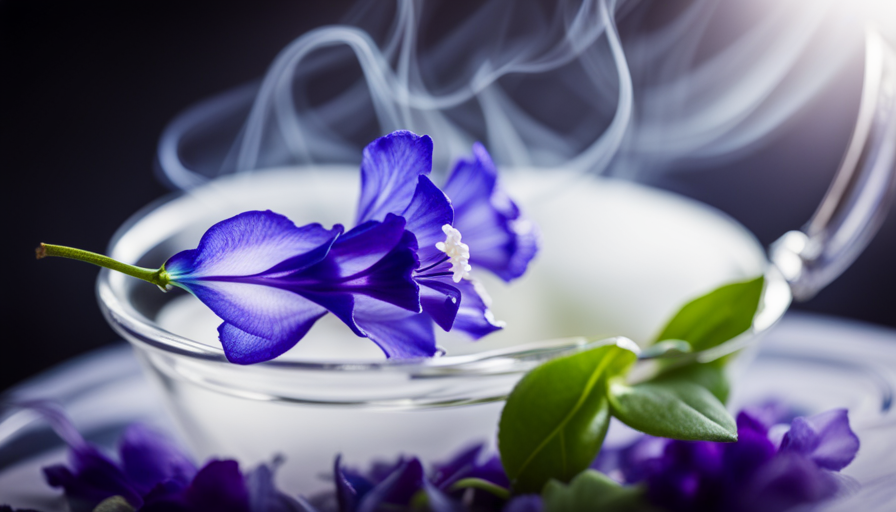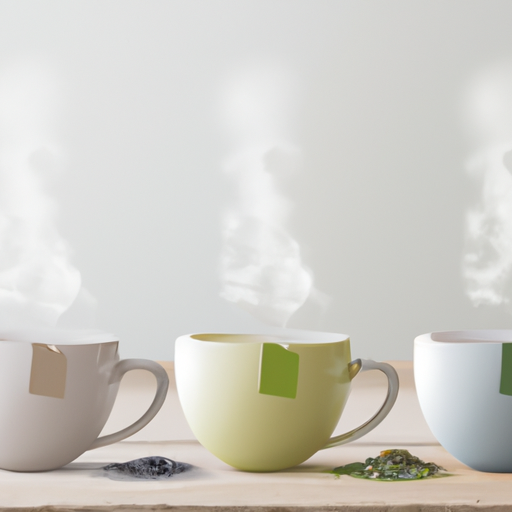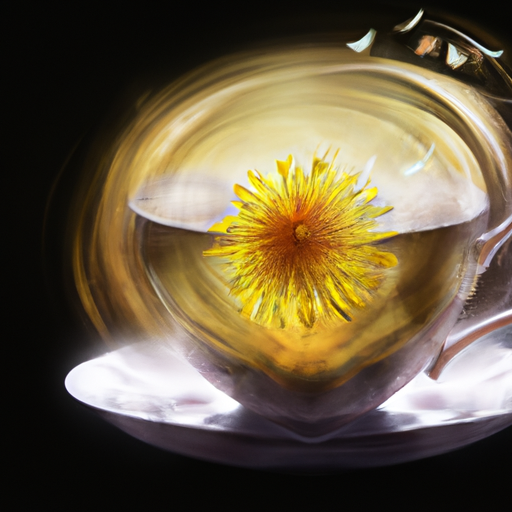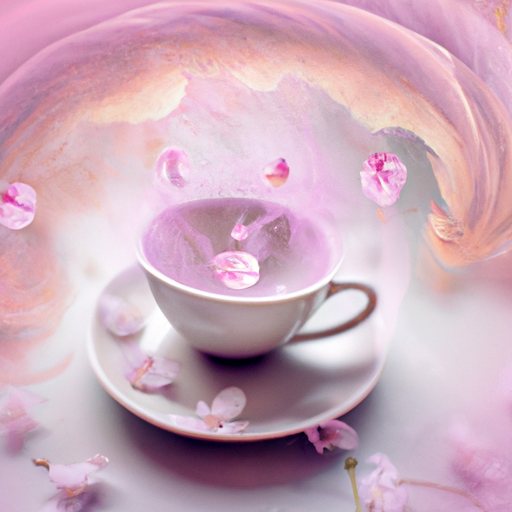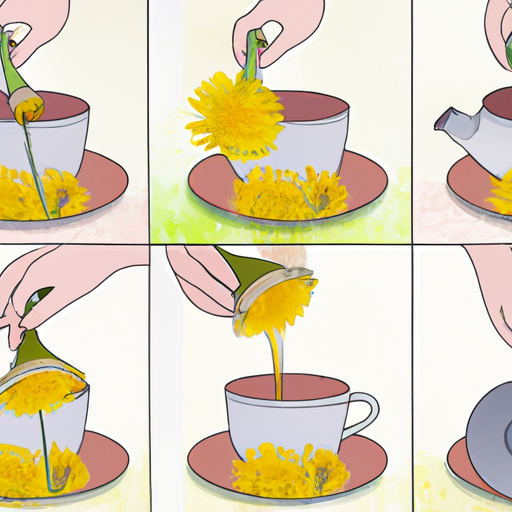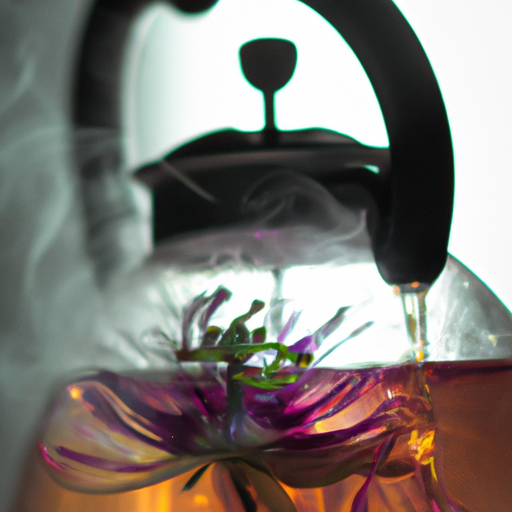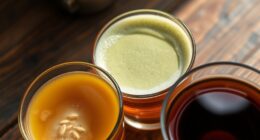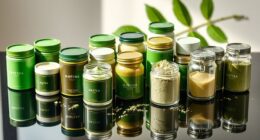In a world filled with a kaleidoscope of flavors and colors, there is a tea that stands out like a vibrant butterfly dancing through a garden. Butterfly pea flower tea, with its mesmerizing blue hue, is a drink that not only captivates the eyes but also tantalizes the taste buds.
As I delve into the depths of this enchanting beverage, I uncover its rich history, the art of its creation, and the potential health benefits it offers. Originating from Southeast Asia, this tea is made from the delicate petals of the Clitoria ternatea plant, carefully harvested and brewed to create a drink that is as beautiful as it is delicious.
Join me on this journey as we explore the allure of butterfly pea flower tea, its place in popular culture, and where to find it. Let’s sip, savor, and discover the magic of this delightful infusion.
Key Takeaways
- Butterfly pea flower tea is a vibrant blue drink made from the petals of the Clitoria ternatea plant, and it has a rich history and cultural significance in Southeast Asian countries.
- The tea is known for its mild and earthy flavor profile, and it can be enjoyed hot or cold, as well as blended with other ingredients for unique concoctions.
- Butterfly pea flower tea offers potential health benefits, including improved digestion, reduced anxiety, antioxidant properties, and support for brain function and memory.
- The tea is not only used for beverages, but also as a natural food coloring in various dishes, and it holds cultural significance in Southeast Asian cuisine.
History and Origins of Butterfly Pea Flower Tea
Step back in time and discover the fascinating history and origins of butterfly pea flower tea. This unique tea has a rich history that dates back centuries, with its origins rooted in Southeast Asia. The butterfly pea flower, also known as Clitoria ternatea, is native to this region and has long been prized for its vibrant blue petals.
The history of butterfly pea flower tea is closely intertwined with the cultures of countries like Thailand, Vietnam, and Malaysia. In these countries, the tea has deep cultural significance and is often used in traditional ceremonies and rituals. It’s believed to have various health benefits, including improved digestion and reduced anxiety.
The vibrant blue color of the tea is what makes it truly special. The petals of the butterfly pea flower contain a natural pigment called anthocyanin, which gives the tea its distinct hue. This color-changing property has made butterfly pea flower tea popular in culinary creations, where it’s used as a natural food dye.
Now that we understand the history and cultural significance of butterfly pea flower tea, let’s delve into the next section and explore the fascinating process of making this delightful beverage.
The Making of Butterfly Pea Flower Tea
When it comes to making butterfly pea flower tea, there are a few key steps to follow. First, the flowers must be carefully harvested and dried to preserve their vibrant blue color and delicate flavor.
Once the flowers are ready, there are various brewing methods and techniques to choose from, each offering a unique taste and experience. From hot brewing to cold steeping, the possibilities are endless when it comes to enjoying the beautiful and refreshing butterfly pea flower tea.
Harvesting and drying the flowers
To create butterfly pea flower tea, you’ll need to pick the vibrant blue flowers at their peak, just like gathering the stars from the night sky. The harvesting process is crucial to ensure the tea’s quality and potency. Here’s a quick rundown of how it’s done:
-
Timing is everything: The flowers should be harvested early in the morning when they’re at their freshest and most vibrant.
-
Gentle plucking: Each flower is carefully handpicked, ensuring that only the fully bloomed ones are selected.
-
Drying with care: After harvesting, the flowers are spread out in a well-ventilated area to dry naturally. This preserves their color and flavor.
Butterfly pea flower tea has been used for centuries in herbal medicine due to its numerous skin health benefits and traditional healing properties. Now that we’ve harvested the flowers, let’s explore the different brewing methods and techniques to unlock the tea’s full potential.
Brewing methods and techniques
Get ready to experience the full flavor and benefits of butterfly pea flower tea by exploring the various brewing methods and techniques. The way you brew this exquisite tea can greatly influence its taste and health benefits. Here are some brewing techniques to help you create the perfect cup of butterfly pea flower tea:
| Brewing Method | Description | Benefits |
|---|---|---|
| Hot Infusion | Steep the flowers in hot water for 5-7 minutes. | Releases antioxidants and promotes relaxation. |
| Cold Infusion | Soak the flowers in cold water overnight. | Preserves the delicate flavor and enhances hydration. |
| Butterfly Pea Lemonade | Mix the brewed tea with lemon juice and sweetener. | Boosts immunity and aids digestion. |
| Butterfly Pea Latte | Add steamed milk to a cup of brewed tea. | Provides a creamy texture and nourishes the body. |
| Butterfly Pea Iced Tea | Brew the tea and serve it over ice. | Refreshing and invigorating on hot summer days. |
By mastering these brewing techniques, you can unlock the full potential of butterfly pea flower tea. Now, let’s delve into the mesmerizing blue color of this enchanting beverage.
The Mesmerizing Blue Color of Butterfly Pea Flower Tea
Experience the enchanting allure of butterfly pea flower tea as its mesmerizing blue color captivates your senses and transports you to a world of pure fascination. This vibrant blue hue has made butterfly pea flower tea a popular choice among those seeking to indulge in the latest blue food trend. With its natural food coloring properties, this tea isn’t just visually stunning but also a healthier alternative to artificial dyes.
The mesmerizing blue color of butterfly pea flower tea is derived from the petals of the Clitoria ternatea plant, which is native to Southeast Asia. When brewed, the petals release their vibrant blue pigment, infusing the water with a deep indigo shade. As you watch the tea steep, the captivating transformation unfolds before your eyes, creating a truly captivating experience.
Beyond its visual appeal, the blue color of butterfly pea flower tea also adds an element of intrigue to your cup. The intensity of the color can vary depending on the concentration of the tea and the pH level of the liquid it’s mixed with. Adding a squeeze of lemon juice, for example, changes the color from blue to purple, further enhancing the magical experience.
As you delve into the flavor profile of butterfly pea flower tea, you’ll discover a delicate earthiness with subtle floral notes. The subsequent section will explore the intricate flavors that make this tea a truly unique and delightful beverage to savor.
Flavor Profile of Butterfly Pea Flower Tea
Butterfly Pea Flower Tea has a unique flavor profile that is both mild and earthy. The taste is subtle and not overpowering, making it a soothing and enjoyable beverage.
Additionally, the tea lends itself well to blending with other ingredients, allowing for endless creative possibilities to enhance its flavor and create new taste experiences.
Mild and earthy taste
Indulge in the delicate flavor of butterfly pea flower tea, as its mild and earthy taste envelops your senses in a soothing embrace. This unique tea is known for its versatility and is often enjoyed on its own or paired with certain flavors to enhance the overall experience. In Thai cuisine, butterfly pea flower tea is traditionally served with a squeeze of lemon juice, which not only adds a refreshing citrusy note but also changes the tea’s color from blue to purple. It is also commonly used as a natural food coloring in various dishes. With its cultural significance in Southeast Asia, this tea offers a glimpse into the rich culinary traditions of the region. Transitioning into the next section, let’s explore the exciting blending options with other ingredients to create delightful concoctions.
Blending options with other ingredients
Discover the endless possibilities of blending butterfly pea flower tea with a variety of ingredients, allowing you to create truly captivating and delectable concoctions that’ll leave your taste buds craving for more.
The mild and earthy taste of butterfly pea flower tea makes it a versatile base for blending techniques. You can mix it with citrus fruits like lemon or lime to add a refreshing tanginess to your tea. For a sweeter twist, try blending it with honey or agave syrup.
The vibrant blue hue of the tea also makes it a perfect choice for colorful cocktails when mixed with spirits like vodka or gin. Get creative and experiment with unique pairings like lavender or mint to enhance the floral notes of the tea.
These blending options open up a whole new world of flavors and experiences.
Transitioning into the next section, let’s explore the potential health benefits of butterfly pea flower tea.
Potential Health Benefits of Butterfly Pea Flower Tea
Did you know that drinking butterfly pea flower tea can potentially offer several health benefits? Scientific research suggests that this vibrant blue tea is packed with antioxidants, which can help protect the body against free radicals and reduce oxidative stress. Additionally, butterfly pea flower tea has been found to have anti-inflammatory properties, which may help alleviate symptoms of inflammation-related conditions such as arthritis.
Furthermore, studies have shown that butterfly pea flower tea may have potential cognitive benefits. It contains compounds that can enhance brain function and improve memory and focus. This makes it a popular choice among students and individuals looking to boost their mental performance.
Moreover, butterfly pea flower tea has been traditionally used in Ayurvedic medicine to support healthy hair and skin. The antioxidants in the tea can promote collagen production, resulting in healthier hair and more youthful-looking skin.
To help you better understand the potential health benefits of butterfly pea flower tea, here is a table summarizing some of its key properties:
| Potential Health Benefits | Scientific Research |
|---|---|
| Antioxidant properties | Protects against free radicals and oxidative stress |
| Anti-inflammatory properties | Alleviates symptoms of inflammation-related conditions |
| Cognitive benefits | Enhances brain function, improves memory and focus |
| Supports healthy hair and skin | Promotes collagen production, resulting in healthier hair and more youthful-looking skin |
With its numerous potential health benefits, it’s no wonder that butterfly pea flower tea is gaining popularity. In the next section, we will explore its culinary uses and recipes, allowing you to enjoy its unique flavor and vibrant color in various ways.
Culinary Uses and Recipes with Butterfly Pea Flower Tea
Butterfly pea flower tea can be incorporated into a variety of culinary creations, adding a unique twist to both sweet and savory dishes. Its vibrant blue color makes it a visually appealing ingredient, and its subtle earthy flavor lends itself well to a wide range of recipes.
In terms of culinary applications, butterfly pea flower tea can be used as a natural food coloring agent to give dishes a beautiful blue hue. It can be infused into creams, syrups, and sauces to create visually stunning desserts. Additionally, it can be used to make refreshing beverages, such as iced teas and cocktails, by simply steeping the flowers in hot water and adding a touch of sweetener.
In traditional recipes, butterfly pea flower tea is often used in Thai cuisine. It’s commonly used to make a traditional drink called ‘nam dok anchan,’ which is made by adding honey and lime juice to the tea. This drink isn’t only visually striking but also has a refreshing taste that’s perfect for hot summer days.
Transitioning into the next section about butterfly pea flower tea in popular culture, this versatile ingredient has gained popularity not only for its culinary uses but also for its potential health benefits.
Butterfly Pea Flower Tea in Popular Culture
Butterfly Pea Flower Tea has gained significant popularity in popular culture, with social media trends and hashtag challenges showcasing the tea’s vibrant blue color and unique properties.
As a tea enthusiast, I’ve noticed countless posts on Instagram and TikTok featuring creative recipes and stunning photos of butterfly pea flower tea.
Additionally, celebrity endorsements and appearances in media have further propelled the tea’s fame, as more and more people are discovering its health benefits and eye-catching visual appeal.
Social media trends and hashtag challenges
One of the most popular social media trends right now is the hashtag challenges, where people come up with creative ways to use butterfly pea flower tea in their daily lives. It’s amazing to see how this vibrant blue tea has gained so much popularity and has become a source of inspiration for countless individuals.
Here are three ways butterfly pea flower tea hashtag challenges are making an impact on mental health:
-
Promoting mindfulness: By encouraging people to take a moment to prepare and enjoy a cup of butterfly pea flower tea, these challenges remind us to slow down, be present, and practice self-care.
-
Boosting creativity: People are finding innovative ways to incorporate butterfly pea flower tea into their recipes, skincare routines, and even artwork. This creative outlet allows individuals to express themselves and find joy in the process.
-
Fostering community: Hashtag challenges bring people together, creating a sense of belonging and connection. It’s inspiring to see individuals sharing their experiences, recipes, and tips, creating a supportive and inclusive community.
As butterfly pea flower tea continues to captivate social media users, its popularity is also spreading to celebrity endorsements and appearances in media, showcasing its versatility and appeal.
Celebrity endorsements and appearances in media
With famous faces from the entertainment industry jumping on board, it’s no wonder that this trendy beverage is making waves in the media and gaining a cult following. Celebrity endorsements and media appearances have played a significant role in bringing butterfly pea flower tea into the spotlight.
Not only have renowned actors and musicians been seen sipping this vibrant blue brew during interviews and red carpet events, but they’ve also taken to social media to showcase their love for this unique tea. These influential figures have helped create a buzz around butterfly pea flower tea, leading to its increased popularity among fans and followers.
But where can you find this mesmerizing tea? Let’s dive into the next section to discover the best places to get your hands on butterfly pea flower tea.
Where to Find Butterfly Pea Flower Tea
You can easily find butterfly pea flower tea at specialty tea shops or online retailers. When it comes to where to buy this unique tea, there are plenty of options available.
If you prefer to physically browse different varieties and brands, specialty tea shops are a great place to start. These shops often carry a wide selection of teas, including butterfly pea flower tea. You can ask the knowledgeable staff for recommendations and even sample different blends before making a decision.
On the other hand, if you prefer the convenience of shopping from home, online stores offer a wide range of options. Websites dedicated to tea sales, as well as larger online retailers, usually have butterfly pea flower tea in stock. They often provide detailed descriptions of each product, allowing you to make an informed choice. Additionally, online shopping allows you to compare prices and read customer reviews, ensuring that you get the best quality tea for your money.
As we move on to the next section, it’s important to consider the sustainability and ethical considerations associated with butterfly pea flower tea.
Sustainability and Ethical Considerations
Consider the environmental impact and ethical implications when choosing your preferred infusion. When it comes to butterfly pea flower tea, it’s important to prioritize ethical sourcing and minimize the environmental impact. Here are three key factors to keep in mind:
-
Sustainable Farming Practices: Look for tea that’s sourced from farms that prioritize sustainable agriculture. This means using organic farming methods, minimizing the use of pesticides and fertilizers, and promoting biodiversity. By supporting farms that prioritize sustainability, you’re contributing to a healthier ecosystem and protecting the environment.
-
Fair Trade Certification: Ensure that the butterfly pea flower tea you choose is ethically sourced and supports fair trade practices. Look for certifications such as Fairtrade or Rainforest Alliance, which ensure that farmers are paid fair wages and work in safe conditions. Supporting fair trade helps to empower farmers and communities, promoting social and economic sustainability.
-
Packaging and Waste Reduction: Consider the packaging and waste associated with your tea choice. Look for brands that use recyclable or biodegradable packaging materials. Additionally, choosing loose-leaf tea over tea bags can help reduce waste, as tea bags often contain plastic and aren’t easily compostable.
By considering these ethical sourcing and environmental impact factors, you can make a conscious choice when selecting your butterfly pea flower tea. In the next section, we’ll delve into the conclusion and final thoughts on butterfly pea flower tea.
Conclusion and Final Thoughts on Butterfly Pea Flower Tea
As I conclude my discussion on the sustainability and ethical considerations of butterfly pea flower tea, I can’t help but reflect on the potential health benefits and cultural significance of this fascinating beverage.
Butterfly pea flower tea isn’t just visually stunning with its vibrant blue hue, but it also offers a range of potential health benefits. It’s rich in antioxidants, which may help combat free radicals and reduce the risk of chronic diseases. Studies have also suggested that the tea may have anti-inflammatory and anti-diabetic properties, making it a valuable addition to a healthy lifestyle.
Beyond its health benefits, butterfly pea flower tea holds cultural significance in many regions. In Southeast Asia, it’s a popular ingredient in traditional recipes and is often used to make vibrant blue desserts and beverages. In Thai culture, the tea is believed to have calming properties and is commonly consumed to promote relaxation and reduce stress. It’s also used in traditional medicine practices in some regions.
Butterfly pea flower tea isn’t just a visually stunning and delicious beverage, but it also offers potential health benefits and carries cultural significance. Whether enjoyed for its taste or its potential wellness properties, this unique tea is definitely worth exploring.
Frequently Asked Questions
What are the different ways to use butterfly pea flower tea in cooking?
Incorporating butterfly pea flower tea into cooking is a delightful experience! Imagine sipping on refreshing butterfly pea flower tea cocktails while indulging in delectable butterfly pea flower tea desserts.
The vibrant blue color of the tea infuses a mesmerizing hue into your culinary creations. From colorful and flavorful cocktails to mouthwatering desserts like cupcakes, puddings, and ice creams, butterfly pea flower tea adds a unique touch that’ll leave your taste buds craving for more.
How does butterfly pea flower tea affect the body’s metabolism?
Butterfly pea flower tea can have a positive effect on weight loss and digestion. Drinking this tea can boost metabolism and aid in weight management. It contains antioxidants that help to detoxify the body and improve digestion.
The tea can also help regulate blood sugar levels and promote a healthy gut. Overall, incorporating butterfly pea flower tea into your diet can have a beneficial impact on your body’s metabolism and digestive system.
Are there any potential side effects or interactions with medications when consuming butterfly pea flower tea?
When consuming butterfly pea flower tea, it’s important to be aware of potential side effects and interactions with medications. Some people may experience digestive issues such as stomach discomfort or diarrhea.
Additionally, there is a possibility of interactions with certain medications, particularly those that affect blood pressure, blood thinning, or hormone regulation. It’s always a good idea to consult with a healthcare professional before incorporating butterfly pea flower tea into your routine, especially if you’re taking any medications.
Can butterfly pea flower tea be used as a natural food coloring alternative?
Butterfly pea flower tea can indeed be used as a natural food coloring alternative. It’s a vibrant blue dye that can add a beautiful hue to various dishes and beverages.
Not only does it provide a visually appealing color, but it also offers numerous health benefits. Butterfly pea flower tea is rich in antioxidants, promotes healthy skin, and boosts brain function. It’s a great option for those looking for a natural and healthy way to enhance the color of their food.
Are there any cultural or traditional uses of butterfly pea flower tea that are not mentioned in the article?
Cultural significance and traditional medicinal uses of butterfly pea flower tea extend beyond what the article mentions.
In some Asian countries, this vibrant blue tea is used in traditional ceremonies and festivals, symbolizing purity and tranquility.
Additionally, it’s believed to have various health benefits such as improving digestion, reducing inflammation, and promoting healthy hair and skin.
Its rich history and diverse applications make butterfly pea flower tea a fascinating part of cultural traditions and wellness practices.
Conclusion
In conclusion, Butterfly Pea Flower Tea is a fascinating and versatile beverage that has captured the attention of many tea enthusiasts. Its vibrant blue color, unique flavor profile, and potential health benefits make it a standout choice.
As a case study, imagine a busy executive who’s constantly under stress. They start incorporating Butterfly Pea Flower Tea into their daily routine and notice a significant reduction in anxiety and improved focus. This real-life example showcases the potential positive impact of this tea on one’s well-being.
With its growing popularity, finding Butterfly Pea Flower Tea is becoming easier, and its sustainability and ethical considerations make it a responsible choice.
Overall, this tea is a delightful addition to any tea lover’s collection.

